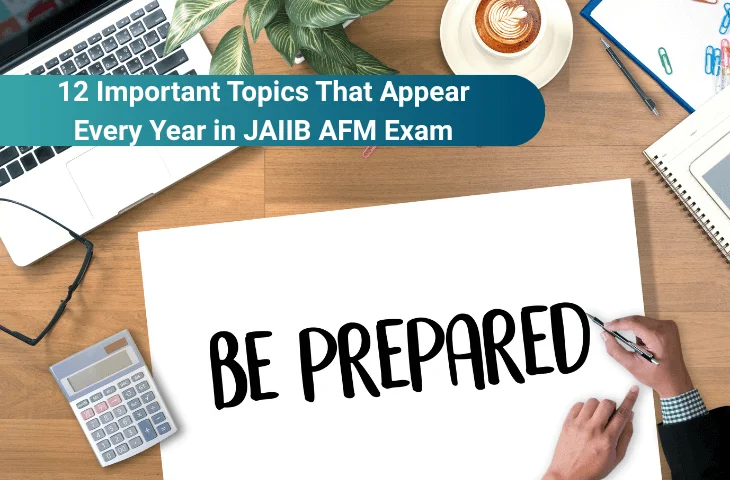The JAIIB (Junior Associate of the Indian Institute of Bankers) exam is one of the most important exams for banking professionals looking to advance their careers in Accounts & Finance Management (AFM). As per the released exam date notice, the JAIIB November cycle exam is scheduled to start from 2nd November, and the AFM paper will be held on 9th November 2025. Aspirants preparing for the IIBF JAIIB November exam must revise these repetitive topics before the exam to score higher marks.
In this blog, we provide a detailed breakdown of the 12 most important AFM topics that mostly appear in the exam. These topics have previously accounted for 30–35 marks in the last 5 exams.
12 Essential JAIIB AFM Topics
The 12 most important topics for the JAIIB AFM exam are as follows:
- Accounting Concept
- Bank Reconciliation
- Rectification of Errors
- How to Maintain Company Accounts
- Cash Flow Statement
- Annuity
- Bond Valuation
- Cost of Capital
- Capital Budgeting
- Tax
- Cost of Accounting Method
- Marginal Costing
JAIIB AFM Exam Pattern
The JAIIB AFM Exam 2025 is conducted in an online mode with no negative marking. The paper consists of 100 questions for 100 marks, and candidates are given 2 hours to complete the paper. After final submission candidates will get to know the total correct answers, they have marked in the paper. The details of the JAIIB exam pattern are as follows:
| Feature | Details |
| Total Questions | 100 objective-type MCQs per paper |
| Total Marks | 100 marks per paper |
| Case-Based Questions | Yes, included in all subjects |
| Numerical Input Questions | Present in papers like AFM |
| Exam Mode | Online (CBT) |
| Negative Marking | No negative marking |
| Assessment Areas | Basic knowledge, application skills, case handling, and numerical aptitude |
Also Check: JAIIB AFM Detailed Syllabus
Module-wise Breakdown of Important Topics
Preparing for AFM (Accounts & Finance Management) can feel challenging due to the vast syllabus, but focusing on high-frequency and repeated topics can give you a major advantage. These topics consistently appear in exams and together cover 30–37 marks. By strategically preparing these, and a few additional subtopics, you can target 50 marks confidently.
Module A: Basics of Accounting
Module A covers the foundational accounting principles that form the backbone of the AFM syllabus. Focusing on these topics ensures that you secure marks with direct questions and case-study-based problems. These topics are repeated in almost every exam and are essential for a strong start.
| Topic | Description | Approx. Marks |
| Accounting Concepts | Core accounting principles; commonly asked in direct questions or case studies. | 2–3 |
| Bank Reconciliation Statement (BRS) | Requires careful practice; recurring in exams; moderately tough but manageable. | 2–3 |
| Rectification of Errors & Depreciation | Frequently repeated topics; need attention to detail for accuracy. | 2–3 |
Module B: Company Accounts
Module B deals with company accounts and cash flow statements. These topics are high-scoring and non-negotiable, often contributing a significant portion of Module B marks. Preparing them thoroughly ensures a solid foundation in corporate accounting.
| Topic | Description | Approx. Marks |
| Company Accounts | Journal entries, accounting cycle, concepts; high-scoring portion of the module. | 5–10 |
| Cash Flow Statement | Covers cash inflows/outflows; essential for exam questions; non-negotiable. | 7–8 |
Module C: Financial Management
Module C is formula-driven and calculation-intensive. Topics in this module are frequently repeated and include both conceptual and numerical questions. Practicing formulas and understanding their derivations will help you secure marks efficiently.
| Topic | Description | Approx. Marks |
| NUT (Numerical Utility Tool) | Formula-driven and calculation-based; minimal effort, consistent marks. | 2 |
| Bond Valuation | Conceptual + numerical questions; includes YTM & duration; recurring topic. | 3 |
| Cost of Capital | Includes equity, debt, preference shares, total cost; important formula-driven topic. | 2–3 |
| Capital Budgeting | Decision-making methods using multiple formulas; unavoidable topic. | 3 |
Module D: Taxation & Cost Accounting
Module D covers taxation and cost accounting, which are high-yield and formula-driven topics. Focusing on the key areas of income tax, GST, and cost accounting methods can easily secure you additional marks.
| Topic | Description | Approx. Marks |
| Income Tax | TDS rates, sections, deductions under Section 80, TCS; frequently asked. | 6 |
| GST | Basic terminology, input tax credit, reverse charge mechanism, registration limits, forms. | 4 |
| Cost Accounting Methods | Selection of method for different businesses and cost computation process. | 5 |
Also Check: JAIIB Admit Card 2025
Last Minute Preparation Strategy
Last-minute preparation strategies before appearing for the JAIIB AFM exam are as follows:
- Focus on High-Weightage Topics – Prioritize these 12 “unavoidable” topics first. They cover 30–37 marks.
- Extend to 15–18 Topics for 50 Marks – Adding a few extra subtopics like Depreciation, Balance Sheet Equation, and Ratios can help cover 50 marks smartly.
- Practice Formulas & Calculations – Modules C and D are formula-heavy. Focus on understanding derivations rather than rote memorization.
- Use PDF & Notes – Prepare using downloadable PDFs for quick revision make structured notes for all topics.
- Mock Tests – Solve last 5-year papers to understand trends. These topics appear repeatedly in exams.
JAIIB AFM May Memory-Based Questions
Q1. Under the Going Concern Assumption, which of the following treatments is most appropriate?
A. Fixed assets are recorded at their current market value every year.
B. All assets are liquidated annually to reflect true worth.
C. Prepaid expenses are deferred and not treated as current period expenses.
D. Profits are distributed even if losses exist.
Answer: C
Q2. In double-entry bookkeeping, if a business buys machinery for ₹5,00,000 by cheque, what is the
correct effect?
A. Debit Cash; Credit Machinery
B. Debit Machinery; Credit Bank
C. Debit Capital; Credit Machinery
D. Debit Purchase; Credit Bank
Answer: B
Q3. A company bought machinery worth ₹4,00,000. It incurred ₹50,000 for transportation, ₹25,000
for installation, and a trade discount of ₹10,000 was allowed. It also paid ₹15,000 for
maintenance during the first year.
What will be the capitalized value of machinery as per cost concept?
A. ₹4,75,000
B. ₹4,65,000
C. ₹4,85,000
D. ₹4,90,000
Answer: A
Explanation: ₹4,00,000 + ₹50,000 + ₹25,000 – ₹10,000 = ₹4,65,000. Maintenance is revenue
expense.
Q4. What is the correct treatment of Bad Debts and Provisions for Doubtful Debts in the financial
statements of banks?
A. Shown under Expenses in the Balance Sheet and Profit in Profit C Loss.
B. Deducted from Gross Advances in the Balance Sheet and recorded under “Provisions and
Contingencies” in PCL.
C. Not disclosed separately in final accounts as per Schedule III.
D. Included only in footnotes and never deducted from advances.
Answer: B
Q5. According to the Companies Act, 2013, which of the following best explains the reason for
maintaining the distinction between different types of companies such as statutory, registered,
foreign, and government companies?
A. This distinction determines the tax liabilities applicable to different classes of companies
only.
B. These categories govern how dividends are calculated and distributed under the Companies
Act.
C. The classification affects legal formation, operational governance, audit requirements, and
compliance protocols defined under respective regulatory statutes.
D. The categories are symbolic and used primarily for internal classification without legal
consequences.
Answer: C
Key Takeaways
| Module | Important Topics | Minimum Marks in Exam | Notes |
| A | Accounting Concepts, BRS, Rectification of Errors, Depreciation | 7–8 | Repeated in all exams, easy to secure marks |
| B | Company Accounts, Cash Flow Statement | 12–13 | Non-negotiable, moderate effort required |
| C | NUT, Bond Valuation, Cost of Capital, Capital Budgeting | 10 | Formula-driven, some conceptual mix |
| D | Income Tax, GST, Cost Accounting Methods | 15 | Focus on core calculations & basic GST concepts |
FAQs
These topics cover around 30–37 marks, and with a few additions, you can target 50 marks easily.
Yes, you can prioritize high-weightage topics first. Minor topics can be prepared partially (60–70%).
Focus on understanding derivations and logic rather than rote memorization. NUT, Bond Valuation, Cost of Capital, and Capital Budgeting need practice calculations.
- 3 Common Mistakes to Avoid While Preparing for JAIIB Exam
- JAIIB RBWM Exam 2025 Analysis 16th November 2025
- Difference Between JAIIB & CAIIB, Eligibility, Exam Pattern
- JAIIB AFM Exam Analysis 2025, 9th November All Shifts Review
- JAIIB PPB Exam Analysis 2025, 8th November All Shifts Review
- JAIIB Exam Analysis 2025, November Cycle, All Shifts Covered

Hi, I’m Aditi. I work as a Content Writer at Oliveboard, where I have been simplifying exam-related content for the past 4 years. I create clear and easy-to-understand guides for JAIIB, CAIIB, and UGC exams. My work includes breaking down notifications, admit cards, and exam updates, as well as preparing study plans and subject-wise strategies.
My goal is to support working professionals in managing their exam preparation alongside a full-time job and to help them achieve career growth.
